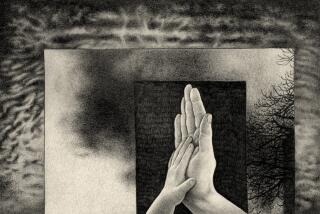Victims of Panic Attacks Learn to Fear Fear Itself
- Share via
VENTURA — The blond-haired woman sits at the brown Formica table in the tan brick room, her husband seated next to her. She talks of lying in bed at night next to her husband and then, once the lights go out, entering a state of fear.
Sometimes, she says, she’ll just fall asleep. That would be good--it’s what she hopes for every night.
But she might also become locked within the fear: alone in the dark, looking up to the ceiling, waiting for things to get worse and yet not knowing what she’s afraid of.
When that happens, her heart pounds, her palms go sweaty, her head feels light, her breathing becomes rapid and shallow--and as each of these scary things intensifies, she fears they will get even worse. Fueled by such fear, they do.
As she sinks into an abyss of no control and paralyzing fright, a voice then goes off in her head: Will I pass out?
Will I die?
The episodes happen a lot. They’ve been happening for years.
Her husband holds her. He stands by her, tries to see her through. But like her, he’s powerless. The tornado of feelings that rips through his wife is larger than either of them.
The woman has been tested for neurological disorders. Psychological problems. Biochemical imbalances in the brain. Physical fitness. Hormonal states. Endocrinological function. Nutritional and metabolic efficiencies.
She’s been diagnosed, misdiagnosed, told she may have this disease, may have that disorder. She’s taken more than six different medicines, among them antidepressants, in an effort to keep the storms at bay. But still she struggles.
That’s because there’s no easy route to finding and naming something called Panic. It wears so many masks, hides behind the symptoms of hypertension, thyroid dysfunction, numerous psychological disorders.
But this woman is healthy, reasonable, charming, together--a competent mother and loving wife.
More than 5% of all Americans suffer as she does from panic attacks. That’s more than 15 million people--and many, many more than actually receive help for it.
*
Seated along facing tables in the same room are others of panic’s pilgrims--people who, of their own choosing, attend twice-a-month group discussions at Ventura County Mental Health Services, across the street from Community Memorial Hospital.
There’s the Ojai woman whose panic paralleled years of not knowing the whereabouts or well-being of her father, recently discovered to be dead.
There’s the Oxnard man who last attended a session two years ago and has coped well since by employing relaxation exercises and avoiding social situations that “trigger” panic responses. But he’s come for a refresher and to bring his sister, seated to his right. His sister, he says, “surprised the heck out of me” when she recently reported having “wild” symptoms she didn’t understand. It seems she was talking to someone on the phone, suddenly felt frightened and, freezing up like a deer in the headlights, lost the ability to speak.
Since panic is not anyone’s badge of honor, this man had never told his sister of his troubles. But he understood her cries all too well.
“Like, does this run in families?” he asks.
And there’s the Ventura man who spent time in a mental hospital years ago for the wrong thing. It was years of immobilizing attacks and misdiagnosis before doctors and his family realized he suffered from panic, whose symptoms mimic those of so many better-understood disorders.
Now the man is coping, he says, but still not free of panic’s terrifying threat. With a sign of unabashed hope, however, he distributes reprints of a magazine article by a Canadian television journalist who chronicles her “out of the blue” debilitation by panic and her slow recovery. In the course of finding her way, the journalist cited current research suggesting panic results from oversensitivity to a brain protein called cholecystokinin (CCK)--a protein that can be blocked by an experimental drug.
*
There are 11 people in all at this meeting. Mostly, they share panic’s war stories--the claustrophobic MRI chamber, the night sweats, the formal party setting that triggers an attack, the meditation exercise that failed, the medication that made things worse, the happy but strange fact that antidepressants do help build a dam against anxiety, panic’s precursor. But always the anecdotes beg the same questions: Where does it come from? Is it psychological? Is it biological? Is it chemical?
Dr. Richard Reinhart, a clinical psychologist, runs these free, open-to-the-public sessions. As his craft would have it, he listens intently, hangs back, tries to guide or elucidate only when necessary. But he does state plainly that in this day of profound medical and psychological sophistication, panic eludes.
Panic, he says, “does seem” to involve the body, the mind, one’s genetic and psychodynamic legacies. Only when all things are taken into account can panic be understood and held at bay--to the extent that it can.
At which point the man with the magazine reprint says, “Well I find this thing about the brain protein that can be stopped to be exciting. It would be really nice if some day we could just take a pill and manage it like a diabetic does with insulin.”
No one could say it simpler. After all, there’s no reason not to hope.
More to Read
Sign up for Essential California
The most important California stories and recommendations in your inbox every morning.
You may occasionally receive promotional content from the Los Angeles Times.













